Report: ISO 9000 Certification and its Impact on Chinese Businesses
VerifiedAdded on 2022/12/01
|17
|3196
|480
Report
AI Summary
This research report investigates the adoption of ISO 9000 certification and its relationship with other factors within China's service industry. It begins with an executive summary, followed by an introduction providing background information on China's rapid economic growth and the importance of quality control, particularly for international businesses. The objective of the research is to help both academics and practitioners understand the relationship between ISO 9000 adoption and other factors within China’s service industry. The report reviews existing literature on factors influencing ISO 9000 adoption, including internal factors such as profitability and efficiency, and external factors like customer pressure. The methodology section describes the use of survey and interview data to explore the motivational factors for ISO 9000 certification in the Chinese context. The analysis and findings section presents descriptive statistics, including frequency distributions and measures of central tendency, as well as inferential statistics such as chi-square, correlation, t-tests, and ANOVA to examine relationships between variables such as certification, sales, and profit. The discussion and recommendations section interprets the findings, suggesting that Chinese organizations adopt ISO standards for various reasons, including improving quality and responding to market demands. Finally, the report concludes with a discussion of limitations and directions for future research.
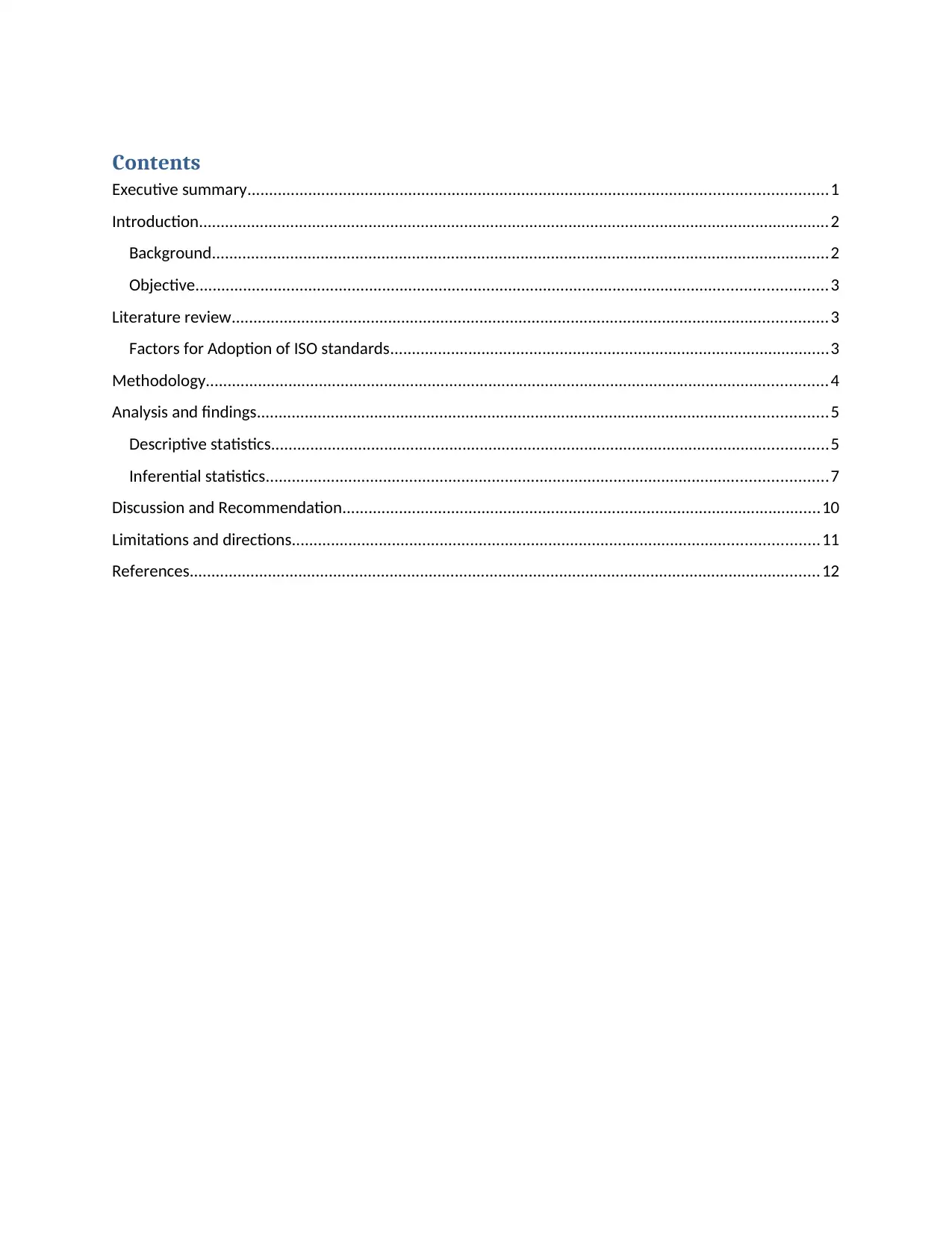
Contents
Executive summary.....................................................................................................................................1
Introduction.................................................................................................................................................2
Background..............................................................................................................................................2
Objective.................................................................................................................................................3
Literature review.........................................................................................................................................3
Factors for Adoption of ISO standards.....................................................................................................3
Methodology...............................................................................................................................................4
Analysis and findings...................................................................................................................................5
Descriptive statistics................................................................................................................................5
Inferential statistics.................................................................................................................................7
Discussion and Recommendation..............................................................................................................10
Limitations and directions.........................................................................................................................11
References.................................................................................................................................................12
Executive summary.....................................................................................................................................1
Introduction.................................................................................................................................................2
Background..............................................................................................................................................2
Objective.................................................................................................................................................3
Literature review.........................................................................................................................................3
Factors for Adoption of ISO standards.....................................................................................................3
Methodology...............................................................................................................................................4
Analysis and findings...................................................................................................................................5
Descriptive statistics................................................................................................................................5
Inferential statistics.................................................................................................................................7
Discussion and Recommendation..............................................................................................................10
Limitations and directions.........................................................................................................................11
References.................................................................................................................................................12
Paraphrase This Document
Need a fresh take? Get an instant paraphrase of this document with our AI Paraphraser
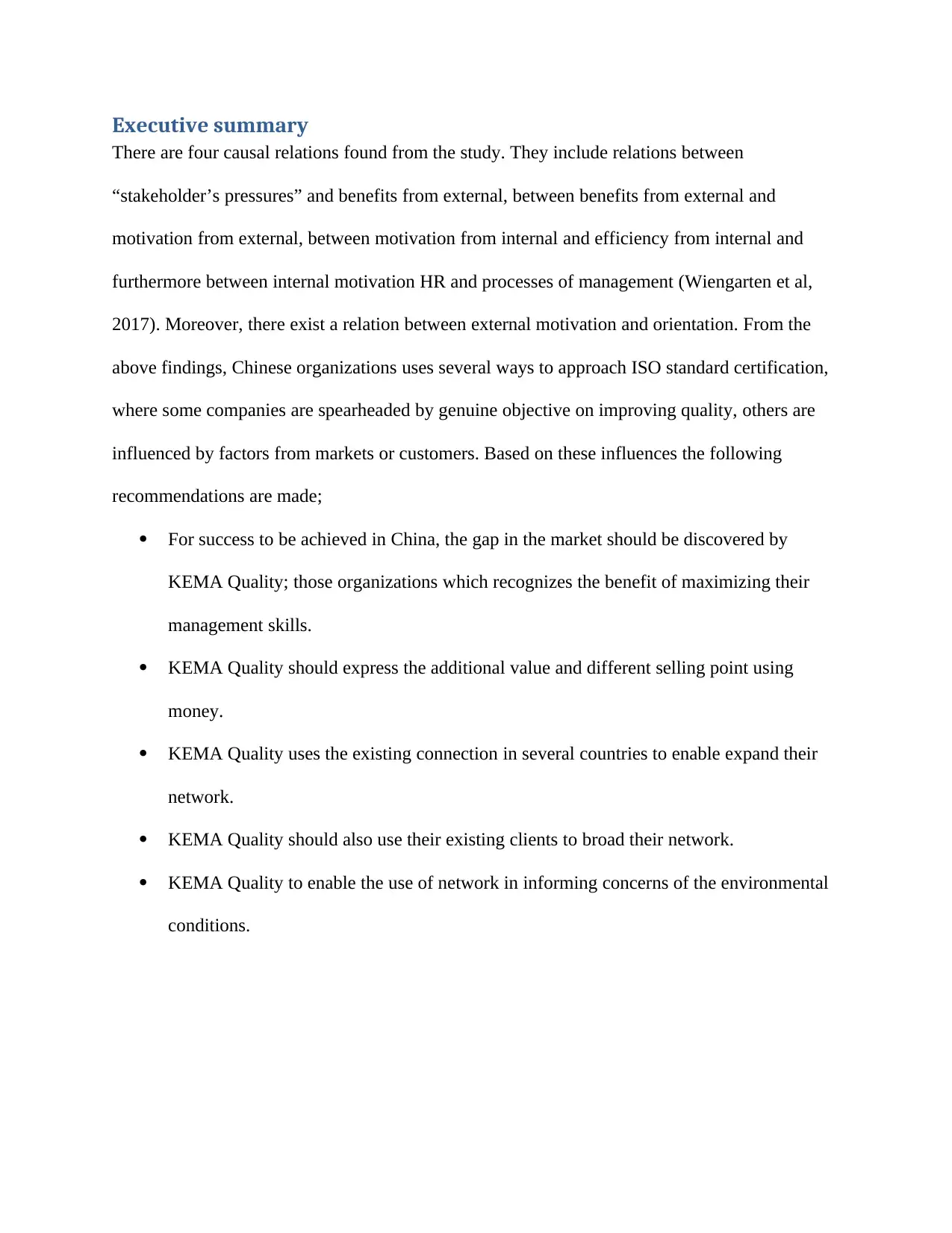
Executive summary
There are four causal relations found from the study. They include relations between
“stakeholder’s pressures” and benefits from external, between benefits from external and
motivation from external, between motivation from internal and efficiency from internal and
furthermore between internal motivation HR and processes of management (Wiengarten et al,
2017). Moreover, there exist a relation between external motivation and orientation. From the
above findings, Chinese organizations uses several ways to approach ISO standard certification,
where some companies are spearheaded by genuine objective on improving quality, others are
influenced by factors from markets or customers. Based on these influences the following
recommendations are made;
For success to be achieved in China, the gap in the market should be discovered by
KEMA Quality; those organizations which recognizes the benefit of maximizing their
management skills.
KEMA Quality should express the additional value and different selling point using
money.
KEMA Quality uses the existing connection in several countries to enable expand their
network.
KEMA Quality should also use their existing clients to broad their network.
KEMA Quality to enable the use of network in informing concerns of the environmental
conditions.
There are four causal relations found from the study. They include relations between
“stakeholder’s pressures” and benefits from external, between benefits from external and
motivation from external, between motivation from internal and efficiency from internal and
furthermore between internal motivation HR and processes of management (Wiengarten et al,
2017). Moreover, there exist a relation between external motivation and orientation. From the
above findings, Chinese organizations uses several ways to approach ISO standard certification,
where some companies are spearheaded by genuine objective on improving quality, others are
influenced by factors from markets or customers. Based on these influences the following
recommendations are made;
For success to be achieved in China, the gap in the market should be discovered by
KEMA Quality; those organizations which recognizes the benefit of maximizing their
management skills.
KEMA Quality should express the additional value and different selling point using
money.
KEMA Quality uses the existing connection in several countries to enable expand their
network.
KEMA Quality should also use their existing clients to broad their network.
KEMA Quality to enable the use of network in informing concerns of the environmental
conditions.
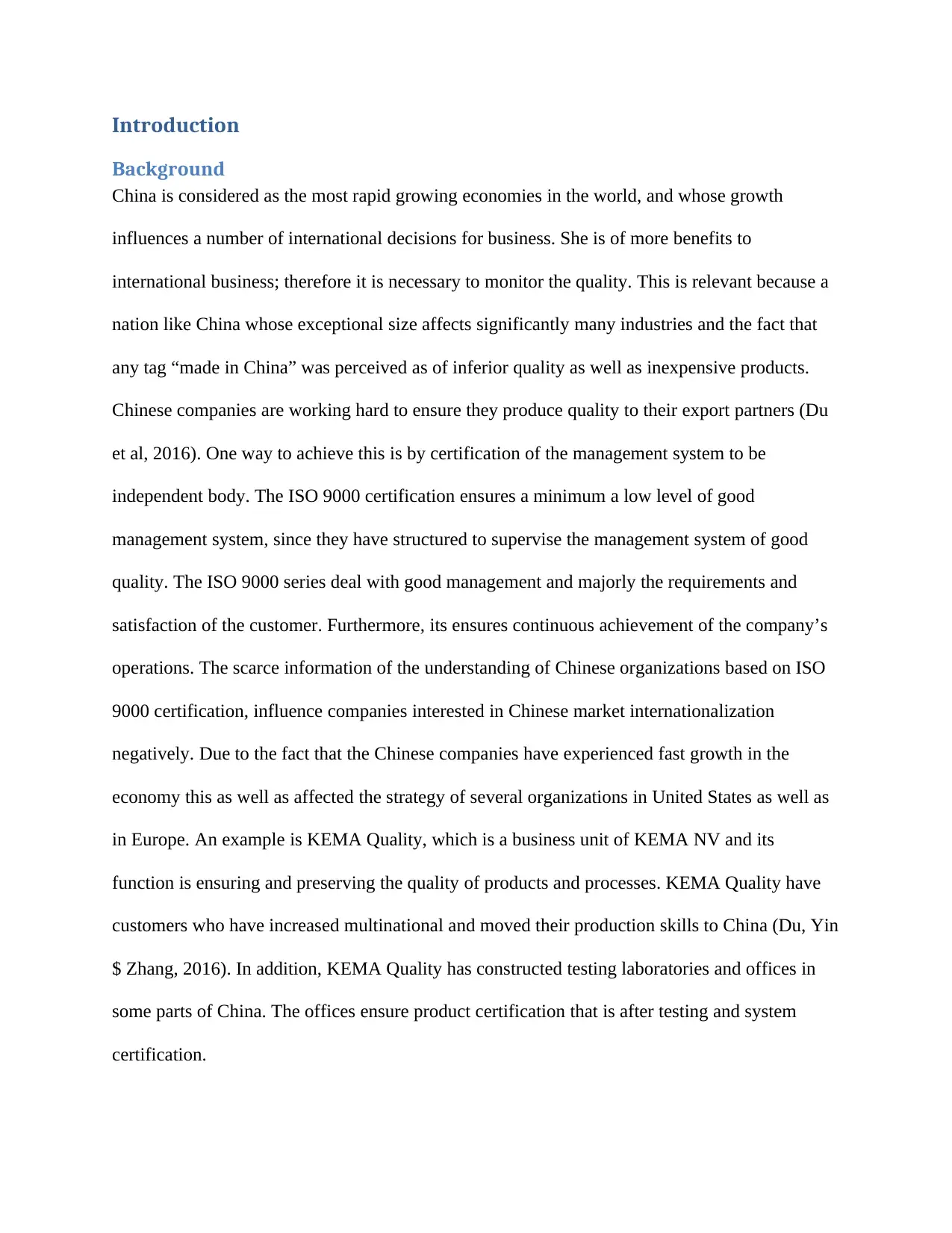
Introduction
Background
China is considered as the most rapid growing economies in the world, and whose growth
influences a number of international decisions for business. She is of more benefits to
international business; therefore it is necessary to monitor the quality. This is relevant because a
nation like China whose exceptional size affects significantly many industries and the fact that
any tag “made in China” was perceived as of inferior quality as well as inexpensive products.
Chinese companies are working hard to ensure they produce quality to their export partners (Du
et al, 2016). One way to achieve this is by certification of the management system to be
independent body. The ISO 9000 certification ensures a minimum a low level of good
management system, since they have structured to supervise the management system of good
quality. The ISO 9000 series deal with good management and majorly the requirements and
satisfaction of the customer. Furthermore, its ensures continuous achievement of the company’s
operations. The scarce information of the understanding of Chinese organizations based on ISO
9000 certification, influence companies interested in Chinese market internationalization
negatively. Due to the fact that the Chinese companies have experienced fast growth in the
economy this as well as affected the strategy of several organizations in United States as well as
in Europe. An example is KEMA Quality, which is a business unit of KEMA NV and its
function is ensuring and preserving the quality of products and processes. KEMA Quality have
customers who have increased multinational and moved their production skills to China (Du, Yin
$ Zhang, 2016). In addition, KEMA Quality has constructed testing laboratories and offices in
some parts of China. The offices ensure product certification that is after testing and system
certification.
Background
China is considered as the most rapid growing economies in the world, and whose growth
influences a number of international decisions for business. She is of more benefits to
international business; therefore it is necessary to monitor the quality. This is relevant because a
nation like China whose exceptional size affects significantly many industries and the fact that
any tag “made in China” was perceived as of inferior quality as well as inexpensive products.
Chinese companies are working hard to ensure they produce quality to their export partners (Du
et al, 2016). One way to achieve this is by certification of the management system to be
independent body. The ISO 9000 certification ensures a minimum a low level of good
management system, since they have structured to supervise the management system of good
quality. The ISO 9000 series deal with good management and majorly the requirements and
satisfaction of the customer. Furthermore, its ensures continuous achievement of the company’s
operations. The scarce information of the understanding of Chinese organizations based on ISO
9000 certification, influence companies interested in Chinese market internationalization
negatively. Due to the fact that the Chinese companies have experienced fast growth in the
economy this as well as affected the strategy of several organizations in United States as well as
in Europe. An example is KEMA Quality, which is a business unit of KEMA NV and its
function is ensuring and preserving the quality of products and processes. KEMA Quality have
customers who have increased multinational and moved their production skills to China (Du, Yin
$ Zhang, 2016). In addition, KEMA Quality has constructed testing laboratories and offices in
some parts of China. The offices ensure product certification that is after testing and system
certification.
⊘ This is a preview!⊘
Do you want full access?
Subscribe today to unlock all pages.

Trusted by 1+ million students worldwide
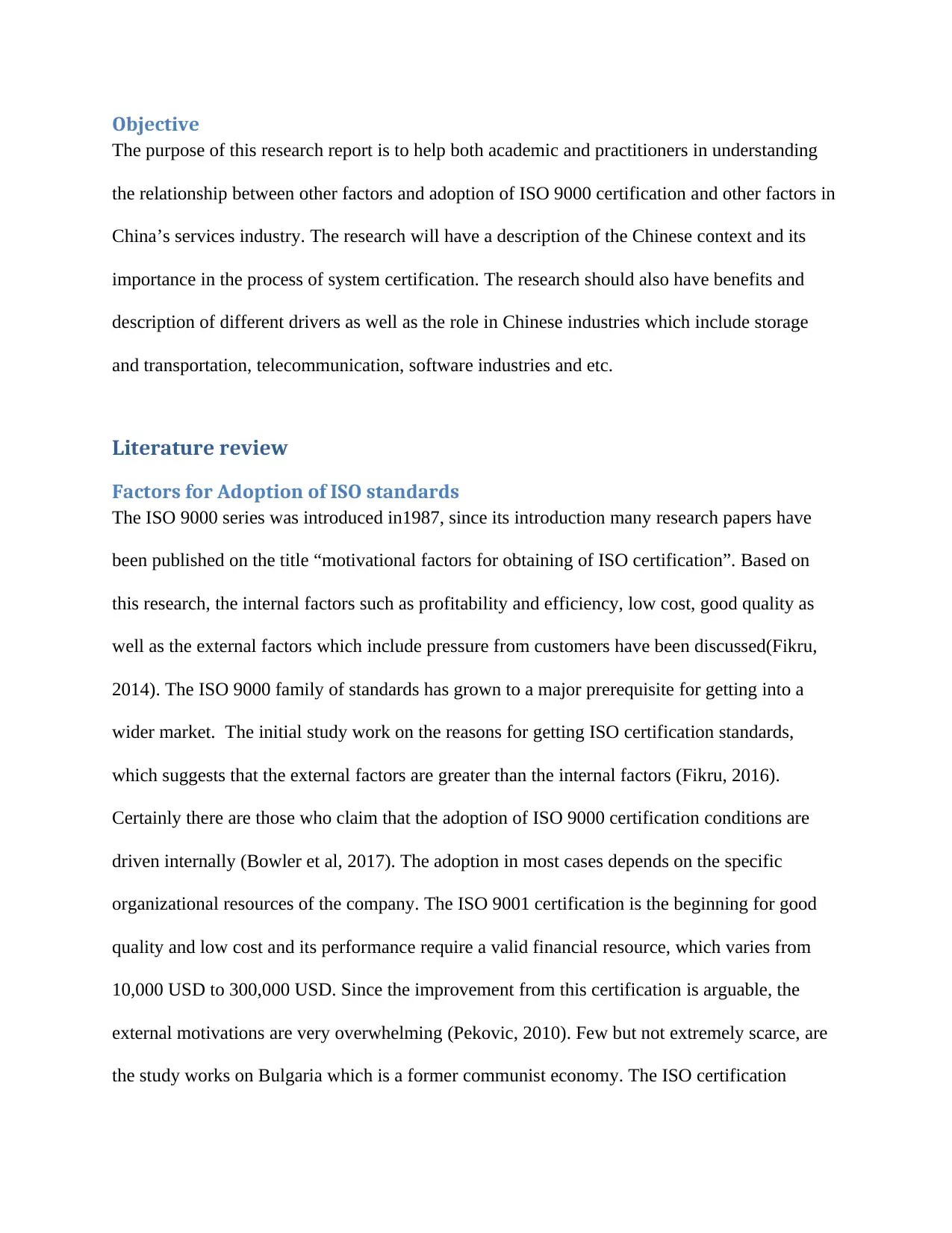
Objective
The purpose of this research report is to help both academic and practitioners in understanding
the relationship between other factors and adoption of ISO 9000 certification and other factors in
China’s services industry. The research will have a description of the Chinese context and its
importance in the process of system certification. The research should also have benefits and
description of different drivers as well as the role in Chinese industries which include storage
and transportation, telecommunication, software industries and etc.
Literature review
Factors for Adoption of ISO standards
The ISO 9000 series was introduced in1987, since its introduction many research papers have
been published on the title “motivational factors for obtaining of ISO certification”. Based on
this research, the internal factors such as profitability and efficiency, low cost, good quality as
well as the external factors which include pressure from customers have been discussed(Fikru,
2014). The ISO 9000 family of standards has grown to a major prerequisite for getting into a
wider market. The initial study work on the reasons for getting ISO certification standards,
which suggests that the external factors are greater than the internal factors (Fikru, 2016).
Certainly there are those who claim that the adoption of ISO 9000 certification conditions are
driven internally (Bowler et al, 2017). The adoption in most cases depends on the specific
organizational resources of the company. The ISO 9001 certification is the beginning for good
quality and low cost and its performance require a valid financial resource, which varies from
10,000 USD to 300,000 USD. Since the improvement from this certification is arguable, the
external motivations are very overwhelming (Pekovic, 2010). Few but not extremely scarce, are
the study works on Bulgaria which is a former communist economy. The ISO certification
The purpose of this research report is to help both academic and practitioners in understanding
the relationship between other factors and adoption of ISO 9000 certification and other factors in
China’s services industry. The research will have a description of the Chinese context and its
importance in the process of system certification. The research should also have benefits and
description of different drivers as well as the role in Chinese industries which include storage
and transportation, telecommunication, software industries and etc.
Literature review
Factors for Adoption of ISO standards
The ISO 9000 series was introduced in1987, since its introduction many research papers have
been published on the title “motivational factors for obtaining of ISO certification”. Based on
this research, the internal factors such as profitability and efficiency, low cost, good quality as
well as the external factors which include pressure from customers have been discussed(Fikru,
2014). The ISO 9000 family of standards has grown to a major prerequisite for getting into a
wider market. The initial study work on the reasons for getting ISO certification standards,
which suggests that the external factors are greater than the internal factors (Fikru, 2016).
Certainly there are those who claim that the adoption of ISO 9000 certification conditions are
driven internally (Bowler et al, 2017). The adoption in most cases depends on the specific
organizational resources of the company. The ISO 9001 certification is the beginning for good
quality and low cost and its performance require a valid financial resource, which varies from
10,000 USD to 300,000 USD. Since the improvement from this certification is arguable, the
external motivations are very overwhelming (Pekovic, 2010). Few but not extremely scarce, are
the study works on Bulgaria which is a former communist economy. The ISO certification
Paraphrase This Document
Need a fresh take? Get an instant paraphrase of this document with our AI Paraphraser
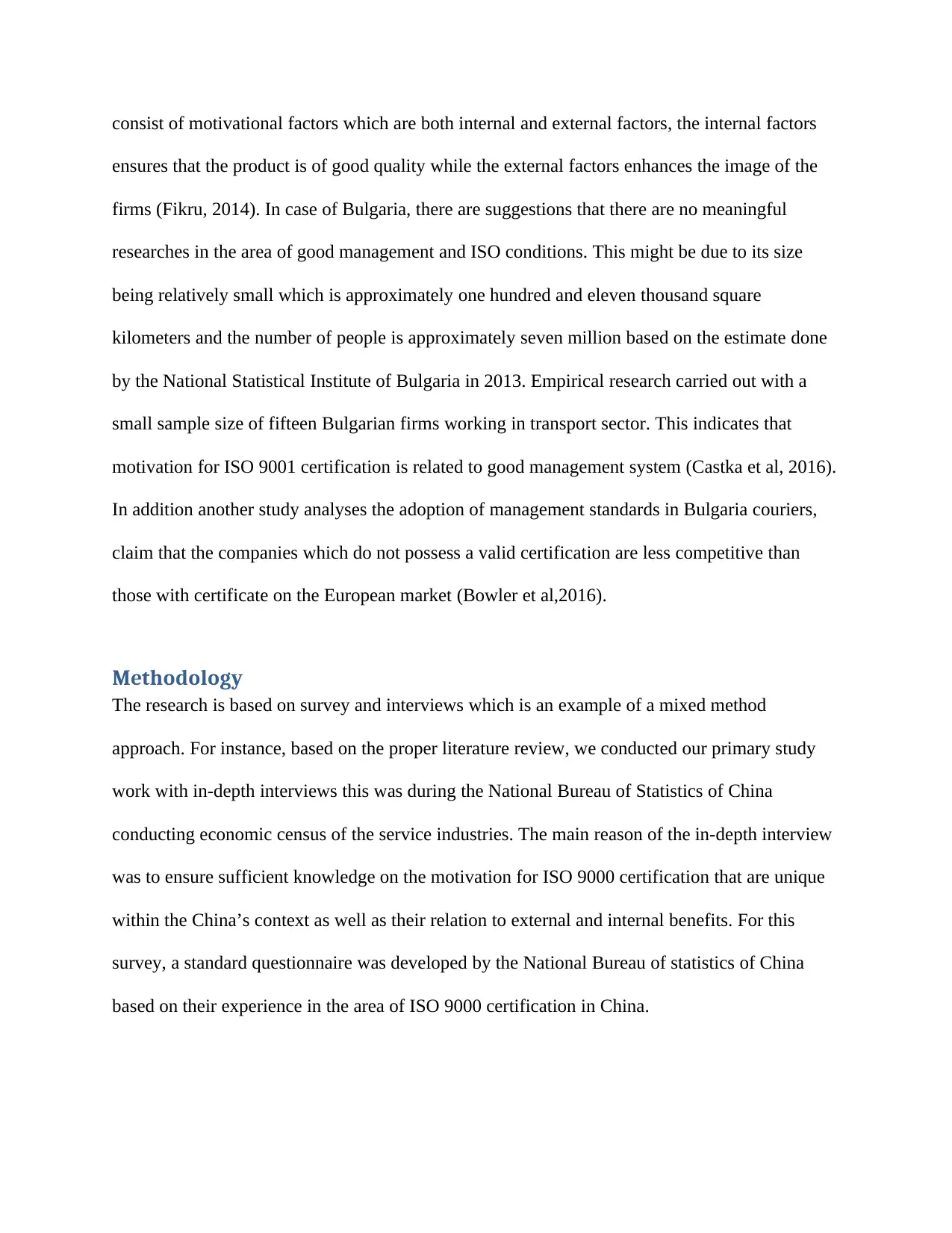
consist of motivational factors which are both internal and external factors, the internal factors
ensures that the product is of good quality while the external factors enhances the image of the
firms (Fikru, 2014). In case of Bulgaria, there are suggestions that there are no meaningful
researches in the area of good management and ISO conditions. This might be due to its size
being relatively small which is approximately one hundred and eleven thousand square
kilometers and the number of people is approximately seven million based on the estimate done
by the National Statistical Institute of Bulgaria in 2013. Empirical research carried out with a
small sample size of fifteen Bulgarian firms working in transport sector. This indicates that
motivation for ISO 9001 certification is related to good management system (Castka et al, 2016).
In addition another study analyses the adoption of management standards in Bulgaria couriers,
claim that the companies which do not possess a valid certification are less competitive than
those with certificate on the European market (Bowler et al,2016).
Methodology
The research is based on survey and interviews which is an example of a mixed method
approach. For instance, based on the proper literature review, we conducted our primary study
work with in-depth interviews this was during the National Bureau of Statistics of China
conducting economic census of the service industries. The main reason of the in-depth interview
was to ensure sufficient knowledge on the motivation for ISO 9000 certification that are unique
within the China’s context as well as their relation to external and internal benefits. For this
survey, a standard questionnaire was developed by the National Bureau of statistics of China
based on their experience in the area of ISO 9000 certification in China.
ensures that the product is of good quality while the external factors enhances the image of the
firms (Fikru, 2014). In case of Bulgaria, there are suggestions that there are no meaningful
researches in the area of good management and ISO conditions. This might be due to its size
being relatively small which is approximately one hundred and eleven thousand square
kilometers and the number of people is approximately seven million based on the estimate done
by the National Statistical Institute of Bulgaria in 2013. Empirical research carried out with a
small sample size of fifteen Bulgarian firms working in transport sector. This indicates that
motivation for ISO 9001 certification is related to good management system (Castka et al, 2016).
In addition another study analyses the adoption of management standards in Bulgaria couriers,
claim that the companies which do not possess a valid certification are less competitive than
those with certificate on the European market (Bowler et al,2016).
Methodology
The research is based on survey and interviews which is an example of a mixed method
approach. For instance, based on the proper literature review, we conducted our primary study
work with in-depth interviews this was during the National Bureau of Statistics of China
conducting economic census of the service industries. The main reason of the in-depth interview
was to ensure sufficient knowledge on the motivation for ISO 9000 certification that are unique
within the China’s context as well as their relation to external and internal benefits. For this
survey, a standard questionnaire was developed by the National Bureau of statistics of China
based on their experience in the area of ISO 9000 certification in China.
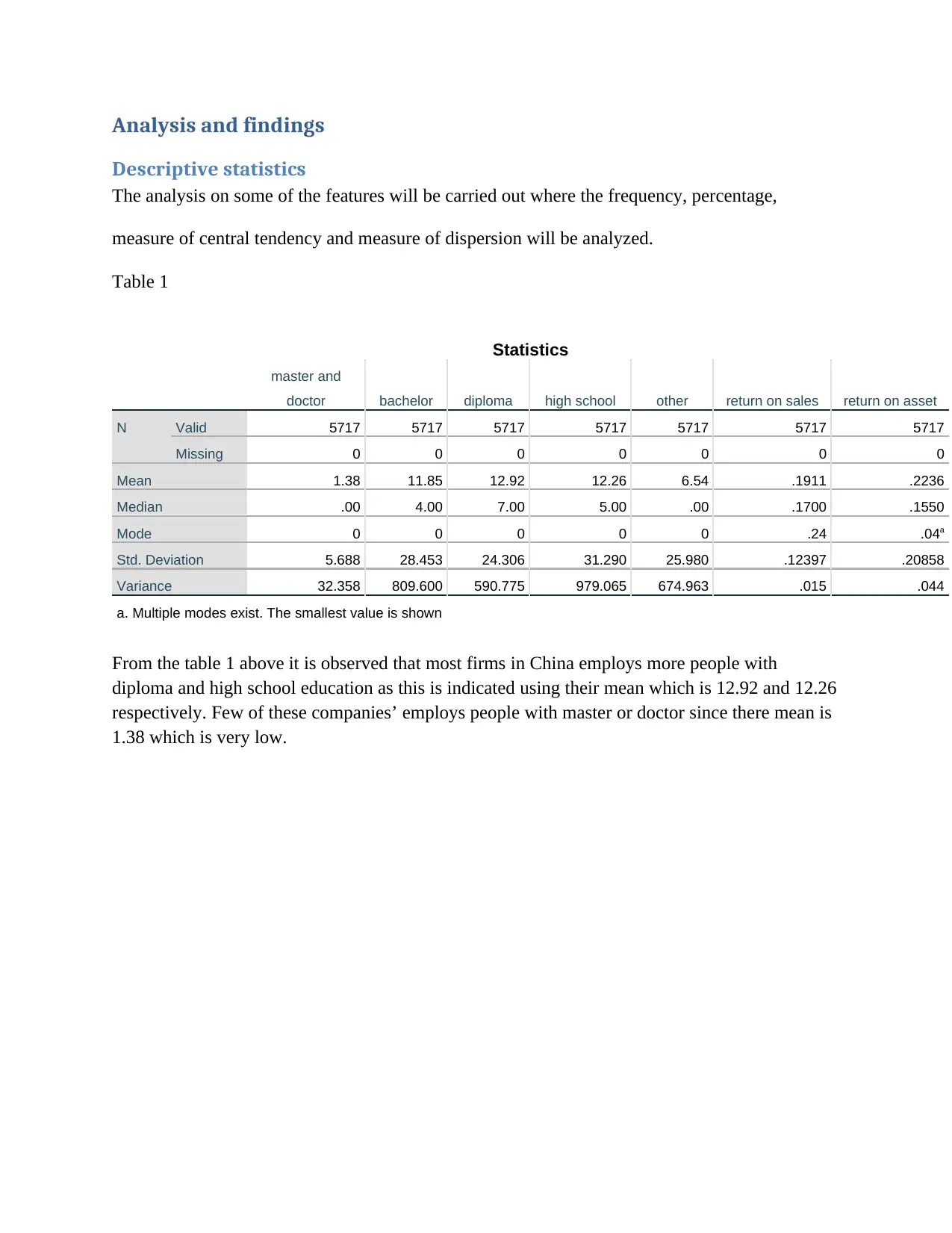
Analysis and findings
Descriptive statistics
The analysis on some of the features will be carried out where the frequency, percentage,
measure of central tendency and measure of dispersion will be analyzed.
Table 1
Statistics
master and
doctor bachelor diploma high school other return on sales return on asset
N Valid 5717 5717 5717 5717 5717 5717 5717
Missing 0 0 0 0 0 0 0
Mean 1.38 11.85 12.92 12.26 6.54 .1911 .2236
Median .00 4.00 7.00 5.00 .00 .1700 .1550
Mode 0 0 0 0 0 .24 .04a
Std. Deviation 5.688 28.453 24.306 31.290 25.980 .12397 .20858
Variance 32.358 809.600 590.775 979.065 674.963 .015 .044
a. Multiple modes exist. The smallest value is shown
From the table 1 above it is observed that most firms in China employs more people with
diploma and high school education as this is indicated using their mean which is 12.92 and 12.26
respectively. Few of these companies’ employs people with master or doctor since there mean is
1.38 which is very low.
Descriptive statistics
The analysis on some of the features will be carried out where the frequency, percentage,
measure of central tendency and measure of dispersion will be analyzed.
Table 1
Statistics
master and
doctor bachelor diploma high school other return on sales return on asset
N Valid 5717 5717 5717 5717 5717 5717 5717
Missing 0 0 0 0 0 0 0
Mean 1.38 11.85 12.92 12.26 6.54 .1911 .2236
Median .00 4.00 7.00 5.00 .00 .1700 .1550
Mode 0 0 0 0 0 .24 .04a
Std. Deviation 5.688 28.453 24.306 31.290 25.980 .12397 .20858
Variance 32.358 809.600 590.775 979.065 674.963 .015 .044
a. Multiple modes exist. The smallest value is shown
From the table 1 above it is observed that most firms in China employs more people with
diploma and high school education as this is indicated using their mean which is 12.92 and 12.26
respectively. Few of these companies’ employs people with master or doctor since there mean is
1.38 which is very low.
⊘ This is a preview!⊘
Do you want full access?
Subscribe today to unlock all pages.

Trusted by 1+ million students worldwide
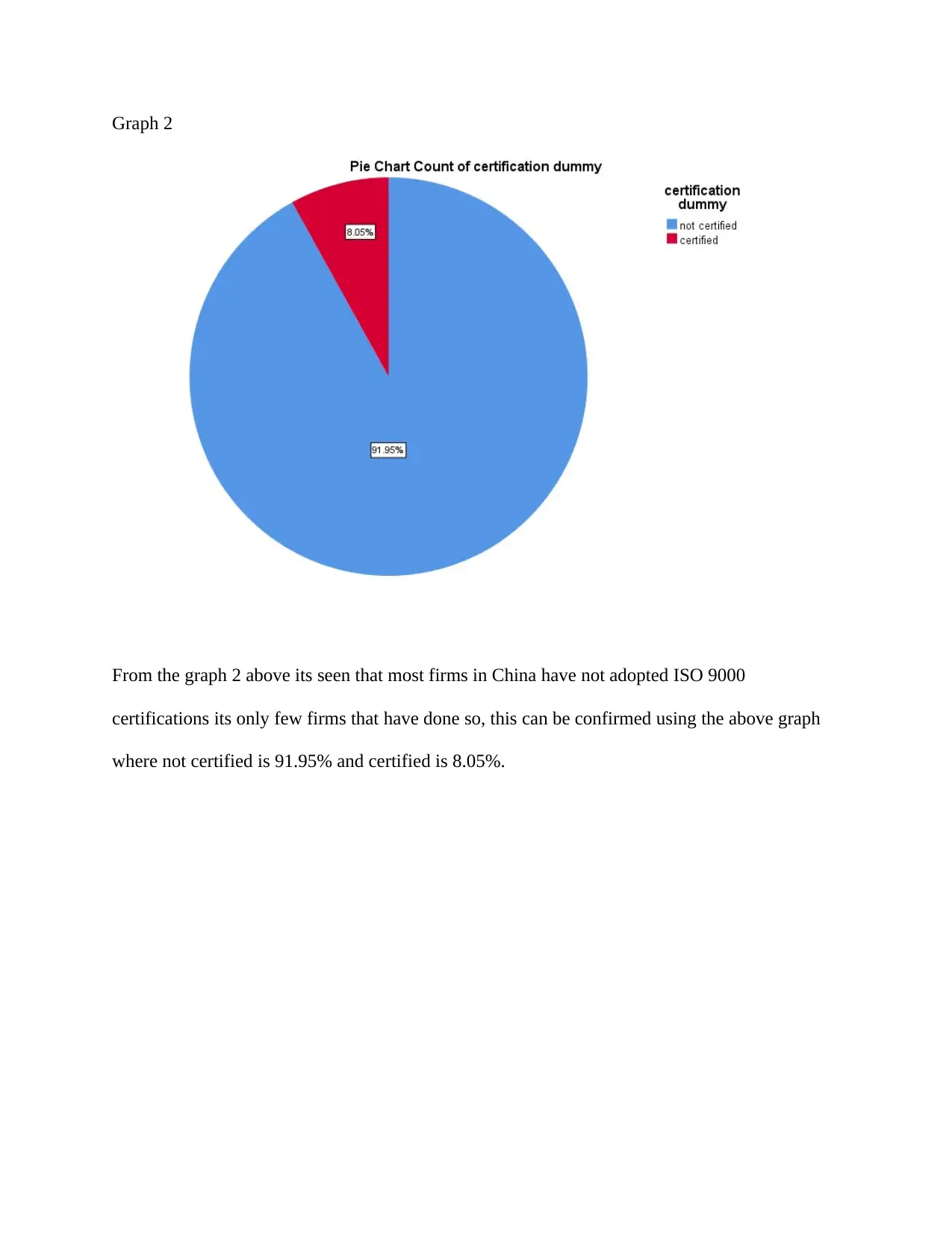
Graph 2
From the graph 2 above its seen that most firms in China have not adopted ISO 9000
certifications its only few firms that have done so, this can be confirmed using the above graph
where not certified is 91.95% and certified is 8.05%.
From the graph 2 above its seen that most firms in China have not adopted ISO 9000
certifications its only few firms that have done so, this can be confirmed using the above graph
where not certified is 91.95% and certified is 8.05%.
Paraphrase This Document
Need a fresh take? Get an instant paraphrase of this document with our AI Paraphraser
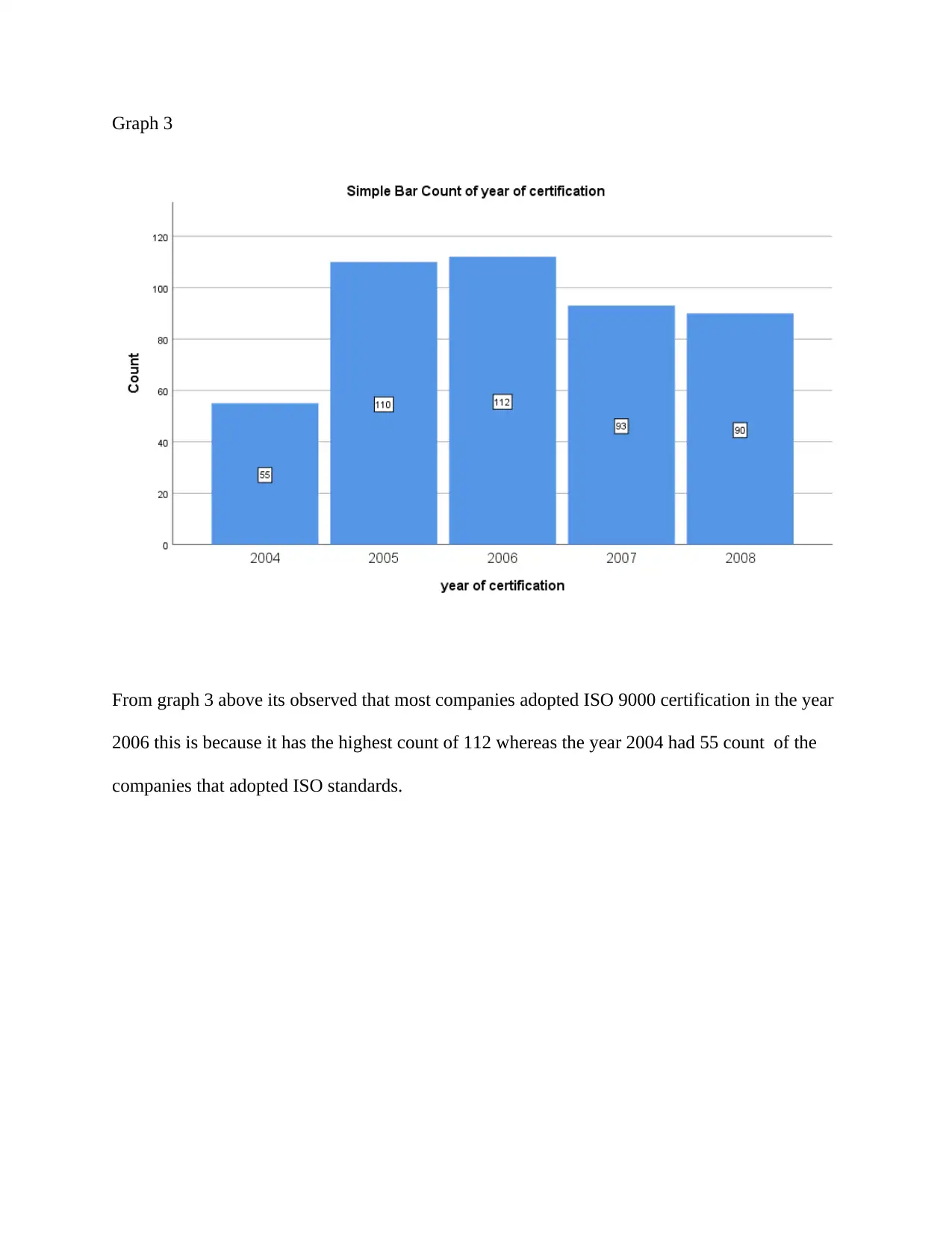
Graph 3
From graph 3 above its observed that most companies adopted ISO 9000 certification in the year
2006 this is because it has the highest count of 112 whereas the year 2004 had 55 count of the
companies that adopted ISO standards.
From graph 3 above its observed that most companies adopted ISO 9000 certification in the year
2006 this is because it has the highest count of 112 whereas the year 2004 had 55 count of the
companies that adopted ISO standards.
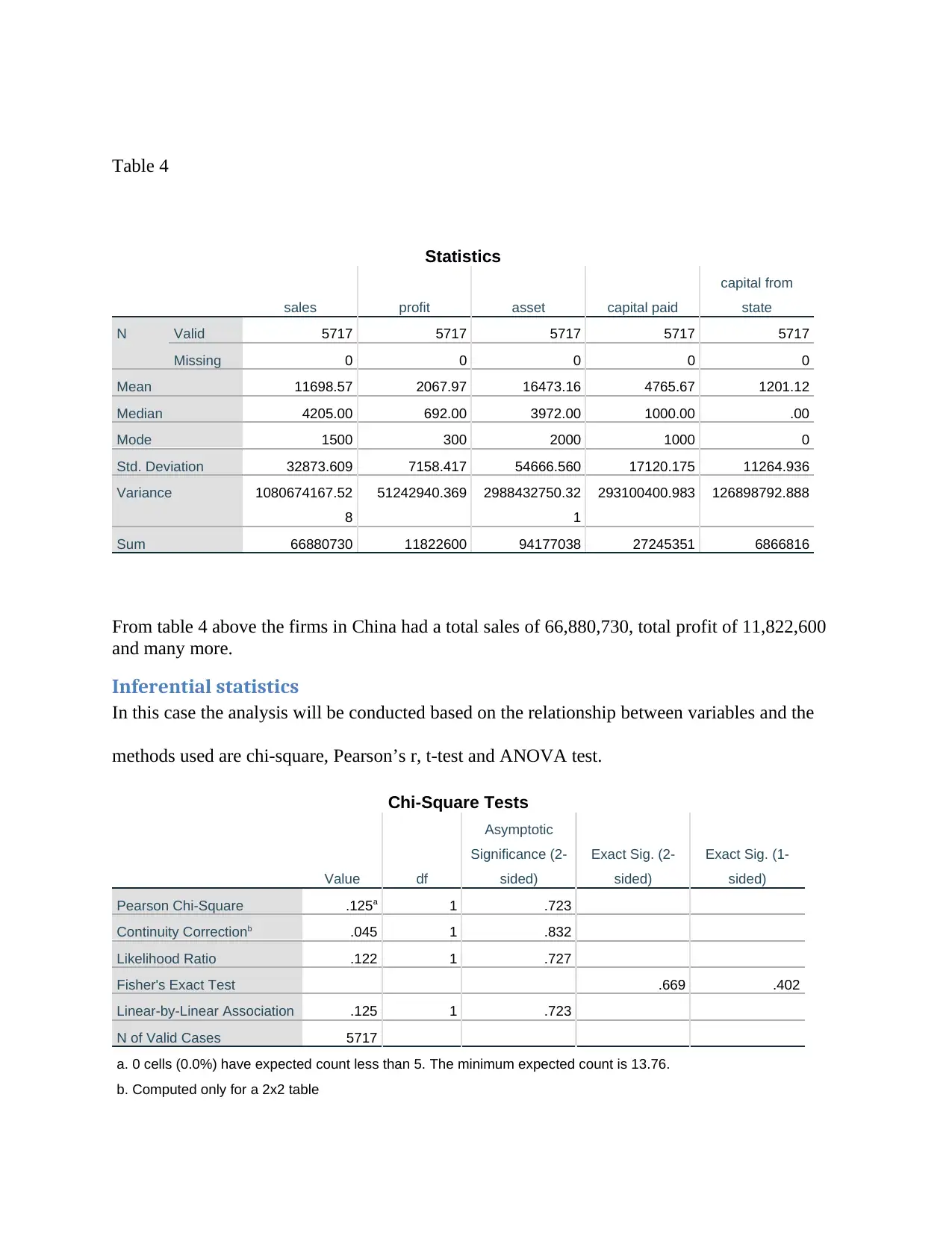
Table 4
Statistics
sales profit asset capital paid
capital from
state
N Valid 5717 5717 5717 5717 5717
Missing 0 0 0 0 0
Mean 11698.57 2067.97 16473.16 4765.67 1201.12
Median 4205.00 692.00 3972.00 1000.00 .00
Mode 1500 300 2000 1000 0
Std. Deviation 32873.609 7158.417 54666.560 17120.175 11264.936
Variance 1080674167.52
8
51242940.369 2988432750.32
1
293100400.983 126898792.888
Sum 66880730 11822600 94177038 27245351 6866816
From table 4 above the firms in China had a total sales of 66,880,730, total profit of 11,822,600
and many more.
Inferential statistics
In this case the analysis will be conducted based on the relationship between variables and the
methods used are chi-square, Pearson’s r, t-test and ANOVA test.
Chi-Square Tests
Value df
Asymptotic
Significance (2-
sided)
Exact Sig. (2-
sided)
Exact Sig. (1-
sided)
Pearson Chi-Square .125a 1 .723
Continuity Correctionb .045 1 .832
Likelihood Ratio .122 1 .727
Fisher's Exact Test .669 .402
Linear-by-Linear Association .125 1 .723
N of Valid Cases 5717
a. 0 cells (0.0%) have expected count less than 5. The minimum expected count is 13.76.
b. Computed only for a 2x2 table
Statistics
sales profit asset capital paid
capital from
state
N Valid 5717 5717 5717 5717 5717
Missing 0 0 0 0 0
Mean 11698.57 2067.97 16473.16 4765.67 1201.12
Median 4205.00 692.00 3972.00 1000.00 .00
Mode 1500 300 2000 1000 0
Std. Deviation 32873.609 7158.417 54666.560 17120.175 11264.936
Variance 1080674167.52
8
51242940.369 2988432750.32
1
293100400.983 126898792.888
Sum 66880730 11822600 94177038 27245351 6866816
From table 4 above the firms in China had a total sales of 66,880,730, total profit of 11,822,600
and many more.
Inferential statistics
In this case the analysis will be conducted based on the relationship between variables and the
methods used are chi-square, Pearson’s r, t-test and ANOVA test.
Chi-Square Tests
Value df
Asymptotic
Significance (2-
sided)
Exact Sig. (2-
sided)
Exact Sig. (1-
sided)
Pearson Chi-Square .125a 1 .723
Continuity Correctionb .045 1 .832
Likelihood Ratio .122 1 .727
Fisher's Exact Test .669 .402
Linear-by-Linear Association .125 1 .723
N of Valid Cases 5717
a. 0 cells (0.0%) have expected count less than 5. The minimum expected count is 13.76.
b. Computed only for a 2x2 table
⊘ This is a preview!⊘
Do you want full access?
Subscribe today to unlock all pages.

Trusted by 1+ million students worldwide
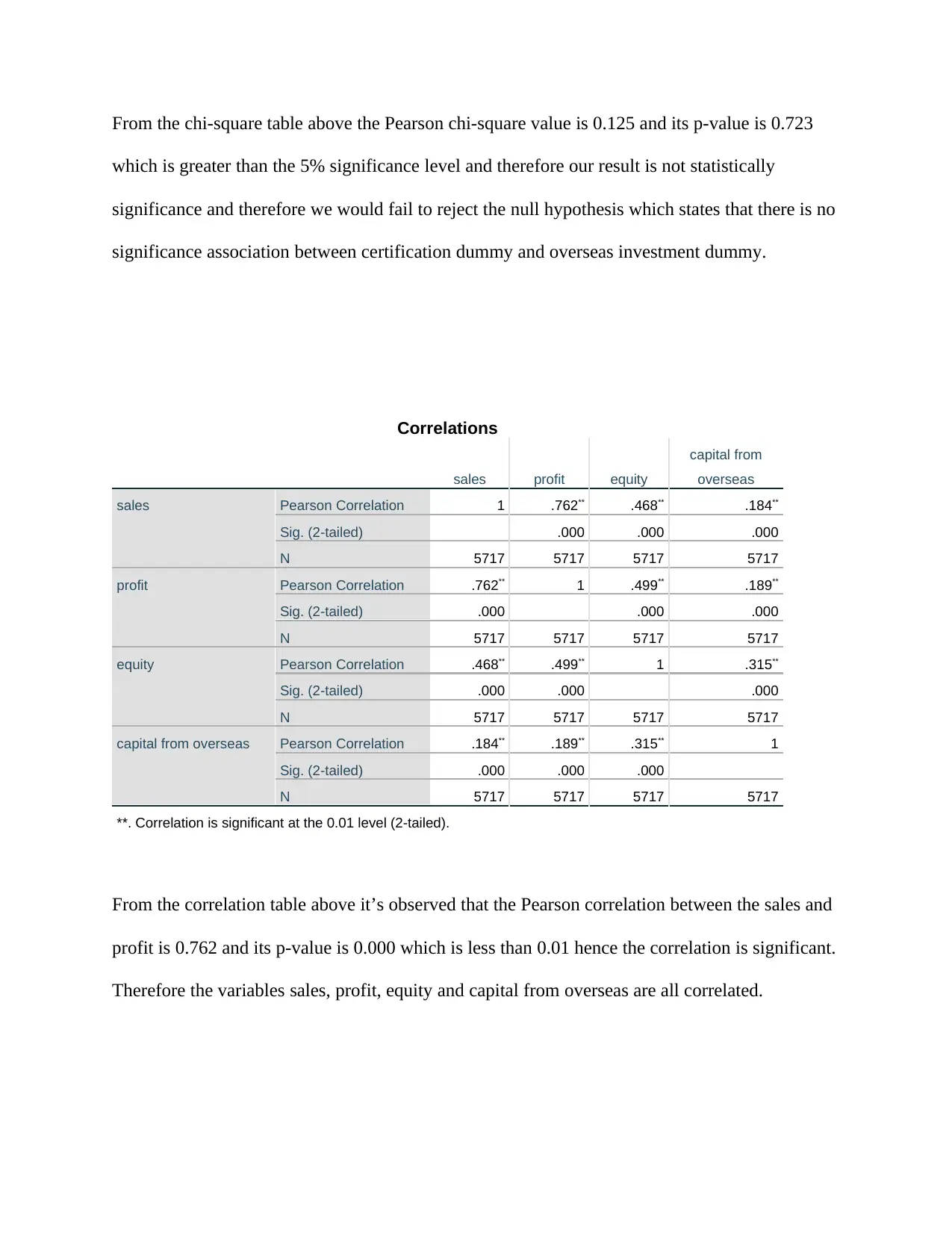
From the chi-square table above the Pearson chi-square value is 0.125 and its p-value is 0.723
which is greater than the 5% significance level and therefore our result is not statistically
significance and therefore we would fail to reject the null hypothesis which states that there is no
significance association between certification dummy and overseas investment dummy.
Correlations
sales profit equity
capital from
overseas
sales Pearson Correlation 1 .762** .468** .184**
Sig. (2-tailed) .000 .000 .000
N 5717 5717 5717 5717
profit Pearson Correlation .762** 1 .499** .189**
Sig. (2-tailed) .000 .000 .000
N 5717 5717 5717 5717
equity Pearson Correlation .468** .499** 1 .315**
Sig. (2-tailed) .000 .000 .000
N 5717 5717 5717 5717
capital from overseas Pearson Correlation .184** .189** .315** 1
Sig. (2-tailed) .000 .000 .000
N 5717 5717 5717 5717
**. Correlation is significant at the 0.01 level (2-tailed).
From the correlation table above it’s observed that the Pearson correlation between the sales and
profit is 0.762 and its p-value is 0.000 which is less than 0.01 hence the correlation is significant.
Therefore the variables sales, profit, equity and capital from overseas are all correlated.
which is greater than the 5% significance level and therefore our result is not statistically
significance and therefore we would fail to reject the null hypothesis which states that there is no
significance association between certification dummy and overseas investment dummy.
Correlations
sales profit equity
capital from
overseas
sales Pearson Correlation 1 .762** .468** .184**
Sig. (2-tailed) .000 .000 .000
N 5717 5717 5717 5717
profit Pearson Correlation .762** 1 .499** .189**
Sig. (2-tailed) .000 .000 .000
N 5717 5717 5717 5717
equity Pearson Correlation .468** .499** 1 .315**
Sig. (2-tailed) .000 .000 .000
N 5717 5717 5717 5717
capital from overseas Pearson Correlation .184** .189** .315** 1
Sig. (2-tailed) .000 .000 .000
N 5717 5717 5717 5717
**. Correlation is significant at the 0.01 level (2-tailed).
From the correlation table above it’s observed that the Pearson correlation between the sales and
profit is 0.762 and its p-value is 0.000 which is less than 0.01 hence the correlation is significant.
Therefore the variables sales, profit, equity and capital from overseas are all correlated.
Paraphrase This Document
Need a fresh take? Get an instant paraphrase of this document with our AI Paraphraser
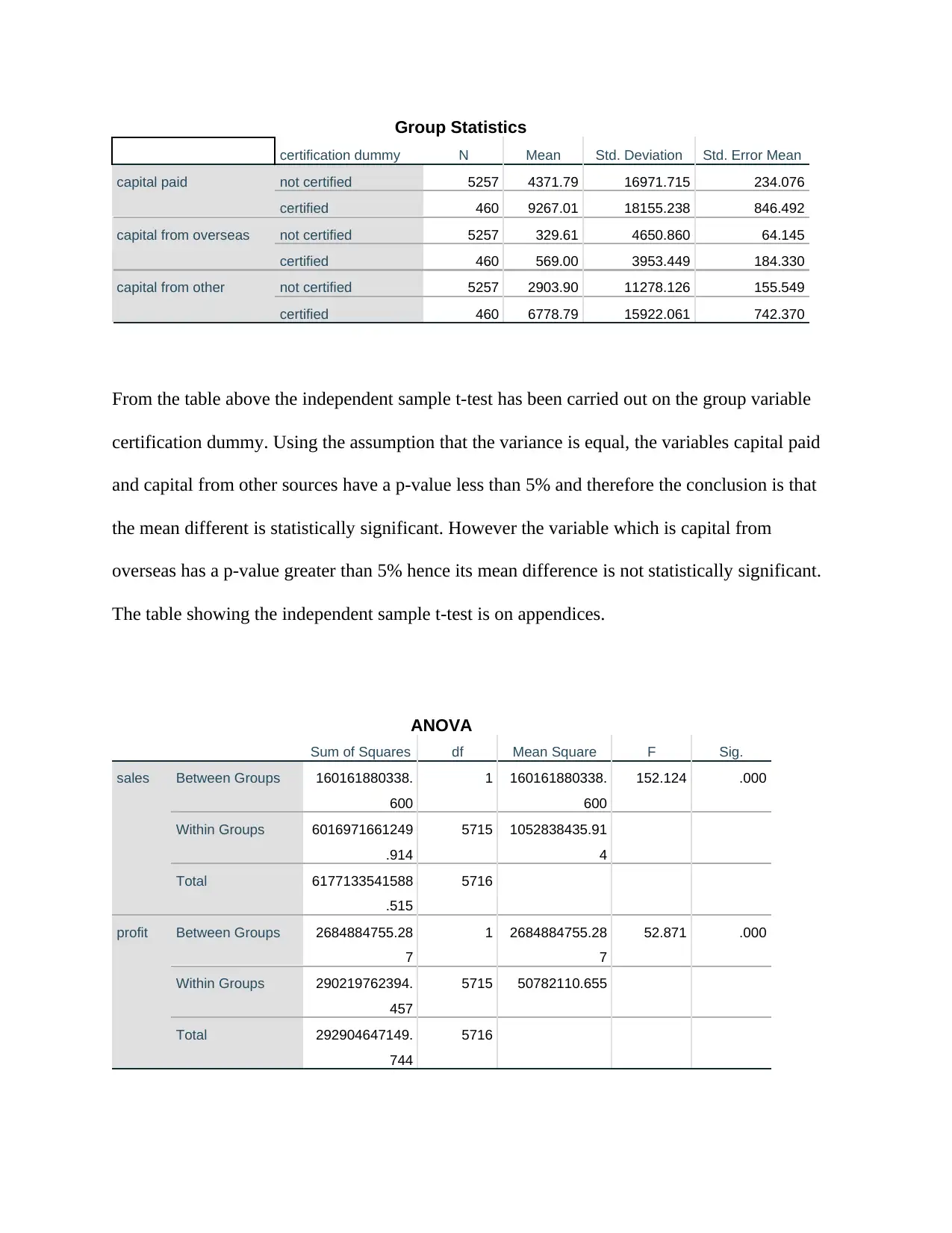
Group Statistics
certification dummy N Mean Std. Deviation Std. Error Mean
capital paid not certified 5257 4371.79 16971.715 234.076
certified 460 9267.01 18155.238 846.492
capital from overseas not certified 5257 329.61 4650.860 64.145
certified 460 569.00 3953.449 184.330
capital from other not certified 5257 2903.90 11278.126 155.549
certified 460 6778.79 15922.061 742.370
From the table above the independent sample t-test has been carried out on the group variable
certification dummy. Using the assumption that the variance is equal, the variables capital paid
and capital from other sources have a p-value less than 5% and therefore the conclusion is that
the mean different is statistically significant. However the variable which is capital from
overseas has a p-value greater than 5% hence its mean difference is not statistically significant.
The table showing the independent sample t-test is on appendices.
ANOVA
Sum of Squares df Mean Square F Sig.
sales Between Groups 160161880338.
600
1 160161880338.
600
152.124 .000
Within Groups 6016971661249
.914
5715 1052838435.91
4
Total 6177133541588
.515
5716
profit Between Groups 2684884755.28
7
1 2684884755.28
7
52.871 .000
Within Groups 290219762394.
457
5715 50782110.655
Total 292904647149.
744
5716
certification dummy N Mean Std. Deviation Std. Error Mean
capital paid not certified 5257 4371.79 16971.715 234.076
certified 460 9267.01 18155.238 846.492
capital from overseas not certified 5257 329.61 4650.860 64.145
certified 460 569.00 3953.449 184.330
capital from other not certified 5257 2903.90 11278.126 155.549
certified 460 6778.79 15922.061 742.370
From the table above the independent sample t-test has been carried out on the group variable
certification dummy. Using the assumption that the variance is equal, the variables capital paid
and capital from other sources have a p-value less than 5% and therefore the conclusion is that
the mean different is statistically significant. However the variable which is capital from
overseas has a p-value greater than 5% hence its mean difference is not statistically significant.
The table showing the independent sample t-test is on appendices.
ANOVA
Sum of Squares df Mean Square F Sig.
sales Between Groups 160161880338.
600
1 160161880338.
600
152.124 .000
Within Groups 6016971661249
.914
5715 1052838435.91
4
Total 6177133541588
.515
5716
profit Between Groups 2684884755.28
7
1 2684884755.28
7
52.871 .000
Within Groups 290219762394.
457
5715 50782110.655
Total 292904647149.
744
5716
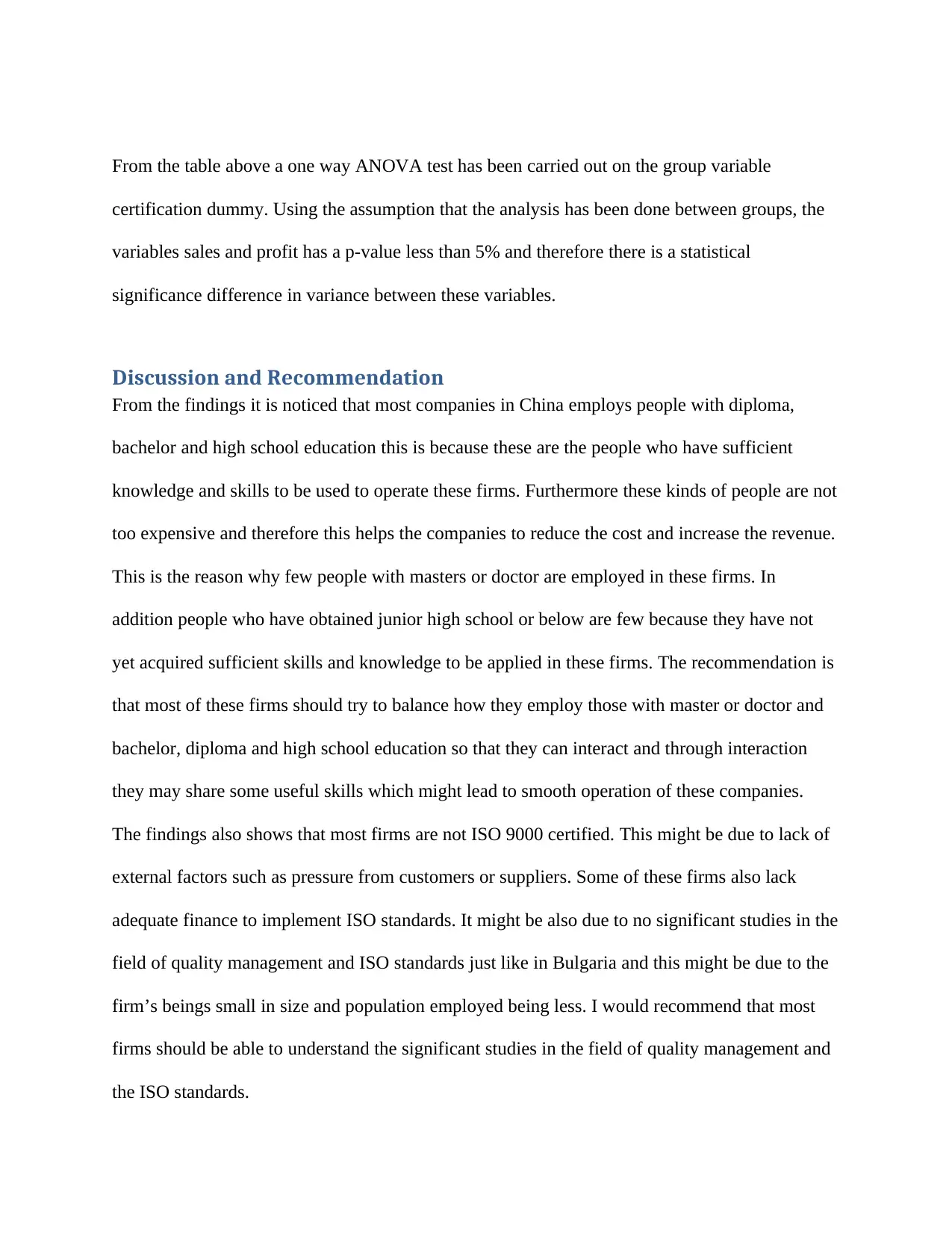
From the table above a one way ANOVA test has been carried out on the group variable
certification dummy. Using the assumption that the analysis has been done between groups, the
variables sales and profit has a p-value less than 5% and therefore there is a statistical
significance difference in variance between these variables.
Discussion and Recommendation
From the findings it is noticed that most companies in China employs people with diploma,
bachelor and high school education this is because these are the people who have sufficient
knowledge and skills to be used to operate these firms. Furthermore these kinds of people are not
too expensive and therefore this helps the companies to reduce the cost and increase the revenue.
This is the reason why few people with masters or doctor are employed in these firms. In
addition people who have obtained junior high school or below are few because they have not
yet acquired sufficient skills and knowledge to be applied in these firms. The recommendation is
that most of these firms should try to balance how they employ those with master or doctor and
bachelor, diploma and high school education so that they can interact and through interaction
they may share some useful skills which might lead to smooth operation of these companies.
The findings also shows that most firms are not ISO 9000 certified. This might be due to lack of
external factors such as pressure from customers or suppliers. Some of these firms also lack
adequate finance to implement ISO standards. It might be also due to no significant studies in the
field of quality management and ISO standards just like in Bulgaria and this might be due to the
firm’s beings small in size and population employed being less. I would recommend that most
firms should be able to understand the significant studies in the field of quality management and
the ISO standards.
certification dummy. Using the assumption that the analysis has been done between groups, the
variables sales and profit has a p-value less than 5% and therefore there is a statistical
significance difference in variance between these variables.
Discussion and Recommendation
From the findings it is noticed that most companies in China employs people with diploma,
bachelor and high school education this is because these are the people who have sufficient
knowledge and skills to be used to operate these firms. Furthermore these kinds of people are not
too expensive and therefore this helps the companies to reduce the cost and increase the revenue.
This is the reason why few people with masters or doctor are employed in these firms. In
addition people who have obtained junior high school or below are few because they have not
yet acquired sufficient skills and knowledge to be applied in these firms. The recommendation is
that most of these firms should try to balance how they employ those with master or doctor and
bachelor, diploma and high school education so that they can interact and through interaction
they may share some useful skills which might lead to smooth operation of these companies.
The findings also shows that most firms are not ISO 9000 certified. This might be due to lack of
external factors such as pressure from customers or suppliers. Some of these firms also lack
adequate finance to implement ISO standards. It might be also due to no significant studies in the
field of quality management and ISO standards just like in Bulgaria and this might be due to the
firm’s beings small in size and population employed being less. I would recommend that most
firms should be able to understand the significant studies in the field of quality management and
the ISO standards.
⊘ This is a preview!⊘
Do you want full access?
Subscribe today to unlock all pages.

Trusted by 1+ million students worldwide
1 out of 17
Related Documents
Your All-in-One AI-Powered Toolkit for Academic Success.
+13062052269
info@desklib.com
Available 24*7 on WhatsApp / Email
![[object Object]](/_next/static/media/star-bottom.7253800d.svg)
Unlock your academic potential
Copyright © 2020–2025 A2Z Services. All Rights Reserved. Developed and managed by ZUCOL.





